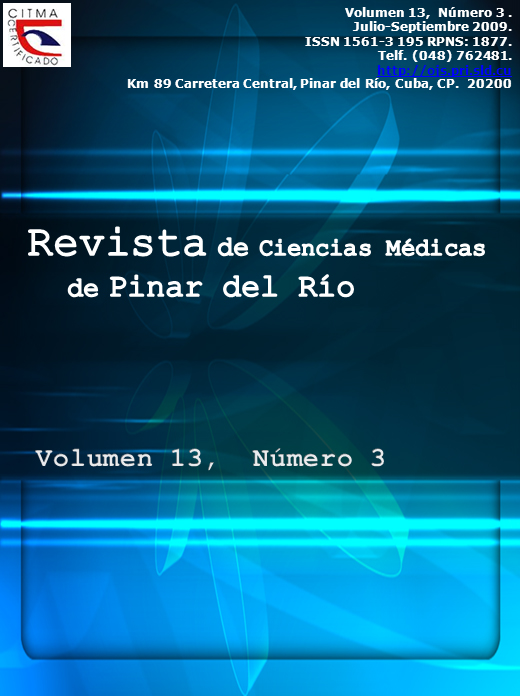Conocimientos de los internos de medicina sobre el programa del diagnóstico prenatal de malformaciones congénitas / Knowledge medical internists have about antenatal diagnosis of congenital malformations
Abstract
La mortalidad perinatal ha descendido a cifras difícilmente modificables. El diagnóstico de las malformaciones fetales se ha convertido en el "caballo de batalla" de la nueva obstetricia. Entrevistamos a 50 internos de medicina de un total de 124, con el objetivo de evaluar el nivel de conocimiento concluido su 6to año, sobre el diagnóstico prenatal de malformaciones congénitas, durante su rotación de gineco-obstetricia en el curso 2007-2008. Del total de estudiantes encuestados solo 19 respondieron correctamente el 50% de la encuesta y ninguno respondió el 100%. Existen dificultades con el nivel de conocimiento de los estudiantes de medicina sobre el valor interpretativo del ultrasonido de programa, las indicaciones de un ECO fetal y la importancia de la genética comunitaria. Por los resultados obtenidos en este trabajo recomendamos revisar y ampliar el programa docente de los internos y estudiantes de medicina, incluyendo conferencias, seminarios y actividades que respondan al contenido obstétrico, genético y comunitario necesarios para promover cada día mejores resultados en el desarrollo del programa materno infantil de la comunidad.
Palabras clave: atención perinatal, anomalías congénitas.
Downloads
References
1-Valdés Pérez O, Parrilla Delgado M.E. Historia del Ultrasonido Diagnóstico. En: Atlas de Ultrasonido Diagnóstico. La Habana: Editorial Científico Técnica, 1982. Pp4-6.
2-Pita Fernández, S. Pruebas diagnósticas. Cad Aten Primaria. 2003; 10: 120-124. Disponible en: http://www.fisterra.com/mbe/investiga/pruebas_diagnosticas/pruebas_diagnosticas2.pdf
3-Gonzalo E. Díaz M. Ecografía. Bogotá, Colombia [serie en internet] 2008[Consultado: Julio 6, 2008]. Disponible en http://www.drgdiaz.com/eco/index.shtml
4-Hernández Serrano L. Notables avances en diagnóstico prenatal. Juventud Rebelde,[serie en internet]2006[Consultado: 10 de mayo del 2006].ISSN 1563-8340.Disponible en: http://www.cubanotable.com
5-Pieri Jiménez X. La policlínica mejora su "salud". CMK Radio Revolución. Salud [serie en internet] 2007[Consultado:6 de Julio 2008] Disponible en: http://www.cubanotable.com
6-Abeledo M I. La salud en Sancti Spíritus durante el 2007. Radio Sancti Spíritus [serie en Internet]2008[Consultado:13 de febrero de 2008].Disponible en: http://www.cubanotable.com
7- Sansó Soberats FJ .El sistema de salud cubano camino a la comunidad. Rev Cubana Med Gen Integr .2004; 20 (1): Disponible en: http://bvs.sld.cu/revistas/mgi/vol20_1_04/mgi01104.htm
8-Hidalgo Rodríguez A. Una salud que crece a la par de la Revolución. La Demajagua. Diario digital de Granma, Cuba.[serie en internet]2008[Consultado 6 de Julio del2008].Disponible en: http://www.cubanotable.com
9-Orraca Castillo M, Iglesias Herrera PR, Morejón Hernández G, Gala Herrera LM. Los Defectos de Cierre del Tubo Neural. Avances [revista en internet]. Junio 2004. 6(2): Disponible en: http://www.ciget.pinar.cu/No.2004-2/pablo.htm
10-Heredero BL. Los servicios de genética médica en Cuba. Journal Genetics. 1997; 20 (supl-1): 47-53
11-De la Osa JA. Labio Leporino, [Serie en internet] 2008[Consultas Mayo 24 ,2008] Disponible en:http://www.consultasmedicas.cu
12-Martín García D, Pairol Acosta I, Ariosa Gurbis L, Hernández J, Ramos García et al. Diagnostico prenatal ultrasonográfico en una familia con síndrome orofaciodigital recesivo ligado al X. Revista Cubana de Genética Humana. 2007; 1(2).
13- PAMI. Taller Provincial sobre diagnóstico prenatal de cardiopatías congénitas. Pinar del Río. Cuba; 2007
14-EEUU. The Patient Education Institute. Ecografía. Medline Plus[Sitio en Internet]. [citado 26 de Noviembre 2007]. Disponible en: http://www.nlm.nih.gov/medlineplus/spanish/tutorials/ultrasoundspanish/rd2091s4.pdf
15-La ecografía es un arte. Disponible en:http://www. forums.obgyn.net/obgin-l/OBGINL.0409/0020.html/ 26 de Noviembre ;2007.
16-Embarazo: Ecografía prenatal [serie en internet]2007[Consultado: 26 de Noviembre 2007].Disponibleen:http://www.carefirst.staywellsolutionsonline.com
17-Vives Iglesias Annia Esther. Ultrasonido diagnóstico: Uso y relación con las competencias profesionales. Rev Cubana Med Gen Integr [revista en la Internet]. 2007 Sep[citado 15 enero 2009]; 23(3): Disponible en: http://scielo.sld.cu/scielo.php?script=sci_arttext&pid=S0864-21252007000300004&lng=es
18- Sosa Olavarria A. Ultrasonografía y Clínica Embrio Fetal.Venezuela: Ed Tatum; 1993.
How to Cite
Issue
Section
License
Authors who have publications with this journal agree to the following terms: Authors will retain their copyrights and grant the journal the right of first publication of their work, which will be publication of their work, which will be simultaneously subject to the Creative Commons Attribution License (CC-BY-NC 4.0) that allows third parties to share the work as long as its author and first publication in this journal are indicated.
Authors may adopt other non-exclusive license agreements for distribution of the published version of the work (e.g.: deposit it in an institutional telematic archive or publish it in a volume). Likewise, and according to the recommendations of the Medical Sciences Editorial (ECIMED), authors must declare in each article their contribution according to the CRediT taxonomy (contributor roles). This taxonomy includes 14 roles, which can be used to represent the tasks typically performed by contributors in scientific academic production. It should be consulted in monograph) whenever initial publication in this journal is indicated. Authors are allowed and encouraged to disseminate their work through the Internet (e.g., in institutional telematic archives or on their web page) before and during the submission process, which may produce interesting exchanges and increase citations of the published work. (See The effect of open access). https://casrai.org/credit/



